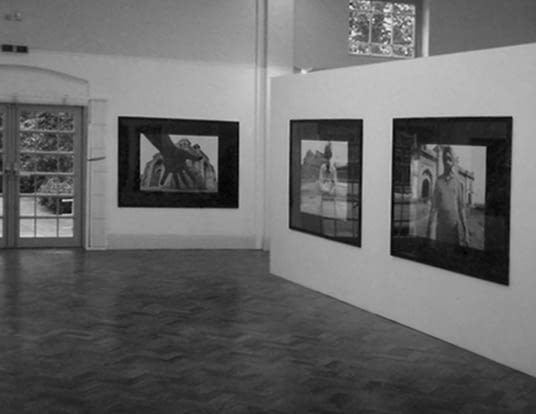REVIEWS
Men of Pukar: Narrating the Non-Narrative
"‘Men of Pukar’ does not try to ‘re-narrate’ Ilango’s Kaveripattinam but Azad has his own heroes and heroines and more often he cuts his depth of focusing short in order to present them within the discursive premises where the incongruity between the history and present day condition of the place is felt. He neither tries to document the relics of the past glory (if there is anything at all) nor claims his images to be that of some ‘historical’ moments. Instead, he allows viewers to delve into the ‘image-space’ for some cultural codes which would help them to re-read the historical narratives in multiple ways." - Bipin Balachandran
Men of Pukar: Witnessing Submergence and Resurgence
"By way of registering the absence of history in the ‘present bodies’ that show no continuity of the said history, Azad almost virtually blurs the bodies and makes them the embodiment of an absent history. It is as good as producing an apparent blurred image through manipulating aperture speed of the camera or by shaking the camera deliberately. Azad’s series ‘Men of Pukar’, in this sense is like hyper-realistic painting done by highly skilled artists in order to take abstraction to its highest form of perfection." - Johny ML
Divine Façades Views of Indian architecture
"The most experimental use of photography is apparent in the work by Abul Kalam Azad. The photographs are large-scale, printed with the entire negative exposed. Some of the principal characters are out of focus, others with their heads chopped out of the frame. These snapshots have a childlike quality to them which is reiterated by scratches and pencil marks over the top of the prints. This results in an interruption to the reality, a re-reading of history and a parody of the human experience often misrepresented in beautiful pictures by tourist boards and Colonial photographs.."
- Michelle McGuire
തെറ്റായ ചരിത്ര, സാംസ്കാരിക നിര്മ്മിതികള്ക്ക് ക്യാമറകൊണ്ടൊരു തിരുത്ത്
"ഞാന് മട്ടാഞ്ചേരിയില് വരുമ്പോള് അത് ഒരു തരത്തിൽ ‘അജ്ഞാതവാസ’മായിരുന്നു. അധികം കാശ് ഇല്ല, ചിലവില്ല, വാടകയില്ല. എന്നെ പോലെ ഡെയിലി വരുമാനം ഇല്ലാത്ത കലാകാരന് ജീവിക്കാനുള്ള നല്ല സ്ഥലം എന്ന രീതിയിലാണ് ഞാന് അവിടെ എത്തുന്നത്. ഞാന് അന്ന് 5,000 രൂപ കൊടുത്തു താമസിച്ച സ്റ്റുഡിയോപിന്നീട് 50,000 രൂപയാണ് വാടക വരുന്നത്."
- അഭിമുഖം, സഫിയ ഒ സി
Bad Moon Raising
"The image, printed on a large canvas, effectively evokes a reaction that fires on multiple registers: it is a cranky animal, you tell yourself. An ill-omened creature. No wonder the demon Mahisha disguised himself as a buffalo. And that thing looks ready to charge."
- Alexander Keefe
Close Encounters
"The myopic eye of the smart phone demands that the photographer has to be within a certain “intimate” distance to take a photograph. There has to be a certain connection between the one who is being photographed and the photographer himself – using a smart phone to create portraits of people means that the photographer is not a mere witness;"
- Arjun Ramachandran
A Silent Documenting Revolution in Thiruvannamalai: Abul Kalam Azad, the Photographer
"Two decades back when Abul Azad showed his independent works to many including me, they all thought that his works were a bit ambitious therefore unconvincing. He was not showing the ‘Raghu Rai School’ of photography. Nor was he making his images in the mode of Kishore Parikh. His photographs were different and disturbing at once."
- Johny ML
Photography: A Colonial Fear
"Photography is the stillness of one by thirty seconds. To copy the dead time… the moments of last forever… photography creates a colonial fear… to shoot… to kill… photography shares the same method of homicide taught by colonialism. That is why we become frozen with horror before a camera. This terror is my medium, and there are some truths inherent in the medium."
- Interview, PP Sha Nawas
Wings Flapping of Migratory Birds in an Anarchist’s Fingers
"In Abul Azad’s visual dictionary the word ‘still life’ is elaborated as follows: the objects related to and resulted by a person’s life and these objects are seen arrayed in a certain fashion as providence would suggest and these objects would remain in the same way as if they were caught in and frozen by time."
- Johny ML
Truth Of The Matter, Reality Of The Image
"Over all, the corpus of Azad’s work can be seen to have a thrust towards an archive of local micro-history at the level of personal memory and in that sense, his works add up to a kind of social anthropology of his land and its people, though not necessarily in the line of tradition of the objective documentary."
- R Nandakumar
On The Photography Of Abul Kalam Azad
"Azad travels through his sense of history with his conscious tool—his camera—and scales out a chronical of a text of visual history of a most troubled time in the human socio-political context of India."
- Kabita Mukhopadhyay
Photos with a difference
"Abul Kalam Azad's overindulgence with Barthesian ideas, and acts of scratching and drawing images, mainly images of violation like sword, torch etc., on photographs bring forth a picture of witchcraft".
- Rakesh Sinha
Chemical strategies of violation
"Abul’s photographs (or work with photographs?) necessitate such a different approach for their successive readings. There is something blasphemous in the conversion of a news photographer into an artist who uses photographs for his creative expression. The blasphemy lies in his bold attempt to subvert the common norms attributed to a photo journalist. "
- Johny ML and Mrinal M Kulkarni
A still Journey Through Time
"Azad photographs with patience, he reaches the space of narrative, accomplishing pictures invariably close to the written word. This verbality in no way diminishes the pictorial curiosity and investigation."
- OV Vijayan














